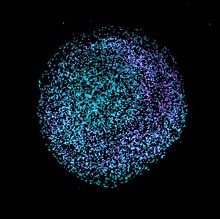Organoid intelligence


Organoid intelligence (OI) is an emerging field of study in computer science and biology that develops and studies biological computing using 3D cultures of human brain cells (or brain organoids) and brain-machine interface technologies.[1] Such technologies may be referred to as OIs.
Differences with non-organic computing
[edit]As opposed to traditional non-organic silicon-based approaches, OI seeks to use lab-grown cerebral organoids to serve as "biological hardware." Scientists hope that such organoids can provide faster, more efficient, and more powerful computing power than regular silicon-based computing and AI while requiring only a fraction of the energy. However, while these structures are still far from being able to think like a regular human brain and do not yet possess strong computing capabilities, OI research currently offers the potential to improve the understanding of brain development, learning and memory, potentially finding treatments for neurological disorders such as dementia.[2]
Thomas Hartung,[3] a professor from Johns Hopkins University, argues that "while silicon-based computers are certainly better with numbers, brains are better at learning." Furthermore, he claimed that with "superior learning and storing" capabilities than AIs, being more energy efficient, and that in the future, it might not be possible to add more transistors to a single computer chip, while brains are wired differently and have more potential for storage and computing power, OIs can potentially harness more power than current computers.[4]
Some researchers claim that even though human brains are slower than machines at processing simple information, they are far better at processing complex information as brains can deal with fewer and more uncertain data, perform both sequential and parallel processing, being highly heterogenous, use incomplete datasets, and is said to outperform non-organic machines in decision-making.[1]
Training OIs involve the process of biological learning (BL) as opposed to machine learning (ML) for AIs. BL is said to be much more energy efficient than ML.[1]
Bioinformatics in OI
[edit]OI generates complex biological data, necessitating sophisticated methods for processing and analysis.[5] Bioinformatics provides the tools and techniques to decipher raw data, uncovering the patterns and insights. A Python interface is currently available for processing and interaction with brain organoids. [6]
Intended functions
[edit]Brain-inspired computing hardware aims to emulate the structure and working principles of the brain and could be used to address current limitations in artificial intelligence technologies. However, brain-inspired silicon chips are still limited in their ability to fully mimic brain function, as most examples are built on digital electronic principles. One study performed OI computation (which they termed Brainoware) by sending and receiving information from the brain organoid using a high-density multielectrode array. By applying spatiotemporal electrical stimulation, nonlinear dynamics, and fading memory properties, as well as unsupervised learning from training data by reshaping the organoid functional connectivity, the study showed the potential of this technology by using it for speech recognition and nonlinear equation prediction in a reservoir computing framework.[7]
Ethical concerns
[edit]While researchers are hoping to use OI and biological computing to complement traditional silicon-based computing, there are also questions about the ethics of such an approach. Examples of such ethical issues include OIs gaining consciousness and sentience as organoids and the question of the relationship between a stem cell donor (for growing the organoid) and the respective OI system.[8]
Enforced amnesia and limits on duration of operation without memory reset have been proposed as a way to mitigate the potential risk of silent suffering in brain organoids.[9]
References
[edit]- ^ a b c Smirnova, Lena; Caffo, Brian S.; Gracias, David H.; Huang, Qi; Morales Pantoja, Itzy E.; Tang, Bohao; Zack, Donald J.; Berlinicke, Cynthia A.; Boyd, J. Lomax; Harris, Timothy D.; Johnson, Erik C.; Kagan, Brett J.; Kahn, Jeffrey; Muotri, Alysson R.; Paulhamus, Barton L. (2023-02-28). "Organoid intelligence (OI): the new frontier in biocomputing and intelligence-in-a-dish". Frontiers in Science. 1. doi:10.3389/fsci.2023.1017235. ISSN 2813-6330.
- ^ "Organoid intelligence: a new biocomputing frontier". Frontiers. Archived from the original on 2023-06-23. Retrieved 2024-01-11.
- ^ "Thomas Hartung | Johns Hopkins | Bloomberg School of Public Health". publichealth.jhu.edu. Retrieved 2024-03-04.
- ^ Hollender, Liad. "Scientists unveil plan to create biocomputers powered by human brain cells". Frontiers. Archived from the original on 2024-01-10. Retrieved 2024-01-11.
- ^ Kagan, Brett J; Kitchen, Andy C; Tran, Nhi T; Habibollahi, Forough; Khajehnejad, Moein; Parker, Bradyn J; Bhat, Anjali; Rollo, Ben; Razi, Adeel; Friston, Karl J (2022-12-07). "In vitro neurons learn and exhibit sentience when embodied in a simulated game-world". Neuron. 110 (23): 3952–3969.e8. doi:10.1016/j.neuron.2022.09.001. ISSN 1097-4199. PMC 9747182. PMID 36228614.
- ^ Jordan, Fred (May 2024). "Open and remotely accessible Neuroplatform for research in wetware computing". Frontiers Media. 7. doi:10.3389/frai.2024.1376042. PMC 11097343.
{{cite journal}}: CS1 maint: date and year (link) - ^ Cai, Hongwei; Ao, Zheng; Tian, Chunhui; Wu, Zhuhao; Liu, Hongcheng; Tchieu, Jason; Gu, Mingxia; MacKie, Ken; Guo, Feng (2023). "Brain organoid reservoir computing for artificial intelligence". Nature Electronics. 6 (12): 1032–1039. doi:10.1038/s41928-023-01069-w. S2CID 266278255.
- ^ Smirnova, L.; Morales Pantoja, I. E.; Hartung, T. (2023). "Organoid intelligence (OI) - the ultimate functionality of a brain microphysiological system". Altex. 40 (2): 191–203. doi:10.14573/altex.2303261. PMID 37009773.
- ^ Tkachenko, Yegor (2024). "Position: Enforced Amnesia as a Way to Mitigate the Potential Risk of Silent Suffering in the Conscious AI". Proceedings of the 41st International Conference on Machine Learning. PMLR. Retrieved 2024-06-11.
